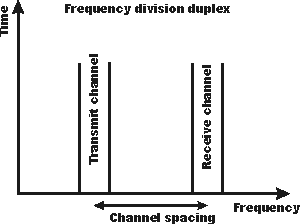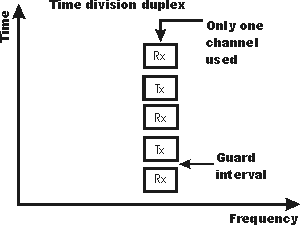TDD FDD Duplex Schemes
The forms of duplex transmission used for cellular technologies including FDD (Frequency Division Duplex) and TDD (Time Division Duplex).
Cellular / Mobile Telecommunications Basics Includes:
What is cellular communications
Concept of cellular system
Radio access network, RAN
Basestation Technology
Base station antenna technology
Multiple access techniques
Duplex techniques
What's inside a cellphone
SIM cards
Handover
Backhaul
One of the key elements of any radio communications system is the way in which radio communications are maintained in both directions. Terms including simplex, duplex, frequency division duplex, FDD, and time division duplex, TDD, are all methods that can be used.
For cellular systems it is necessary that it is possible to talk or send data in both directions simultaneously, and this places a number of constraints on the schemes that may be used to control the transmission flow. As it is such a key element of the system, it is necessary to settle on the scheme that will be used from outset. As a result the duplex scheme to be used forms a very basic part of the overall specification for the cellular (or any radio communications system) that is to be used.
The different schemes for controlling the transmission range from simplex through half duplex to full duplex. Furthermore, schemes such as TDD and FDD need to be defined for the system depending upon its application and the traffic it is likely to carry. Many aspects of the performance will be governed by aspects such as whether FDD or TDD is used.
Transmission control schemes
There are a variety of different ways of controlling the two way passage of information using two transmitters. They range in complexity from the simplest systems requiring the least complex circuitry and providing more basic performance, to more complex systems providing higher levels of performance. However each scheme has its own advantages and disadvantages.
- Simplex: Although the definition of simplex is not always clear the ANSI (American National Standards Institute) definition for a simplex transmission, is one that can only occur in one direction. One example of this may be a broadcast system. Occasionally simplex may refer to a half duplex scheme as described below.
- Half duplex: This is a duplex scheme whereby communication is possible in two directions, but communication is only possible in one direction at a time. If one transmitter is transmitting, the other one must wait until the first stops before transmitting. This form of communication is used for walkie-talkies, CB, etc. It may also be referred to as Simplex, in some circumstances although exact definitions can be contradictory at times.
- Full duplex: Full duplex, which is sometimes referred to simply as duplex is a scheme whereby transmissions may be sent in both directions simultaneously. However it sis till necessary for the transmissions to be separated in some way to enable the receivers to receive signals at the same time as transmissions are being made. There are two ways of achieving this. One is to use frequency separation (frequency division duplex, FDD, and the other is to use time, time division duplex, TDD.
The two schemes are both widely used. Some cellular systems use TDD while others use FDD. Some standards also allow for the use of either as both FDD and TDD have their own advantages and disadvantages.
Frequency division duplex, FDD
Frequency division duplex, FDD, uses the idea that the transmission and reception of signals are achieved simultaneously using two different frequencies. Using FDD it is possible to transmit and receive signals simultaneously as the receiver is not tuned to the same frequency as the transmitter as shown.

For the FDD scheme to operate satisfactorily, it is necessary that the frequency, i.e. channel separation between the transmission and reception frequencies must be sufficient to enable the receiver not to be unduly affected by the transmitter signal. This is known as the guard band.
Receiver blocking is an important issue with FDD schemes, and often highly selective filters may be required. For cellular systems using FDD, filters are required within the base station and also the handset to ensure sufficient isolation of the transmitter signal without desensitising the receiver. While cost is not such a significant driver for the base stations, placing a filter into the handsets is more of an issue.
The use of an FDD system does enable true simultaneous transmission and reception of signals. However two channels are required and this may not always use the available spectrum efficiently.
The spectrum used for FDD systems is allocated by the regulatory authorities. As there is a frequency separation between the uplink and downlink directions, it is not normally possible to reallocate spectrum to change the balance between the capacity of the uplink and downlink directions if there are changing capacity requirements for each direction.Time division duplex, TDD
The other system uses only a single frequency and it shares the channel between transmission and reception, spacing them apart by multiplexing the two signals on a time basis. Time Division Duplex, TDD, is used with data transmissions (data or digitised voice), transmitting a short burst of data in each direction. As the transmission periods are relatively short no time delay is noticed on voice transmissions resulting from the time delays introduced by using TDD.

While FDD transmissions require a guard band between the transmitter and receiver frequencies, TDD schemes require a guard time or guard interval between transmission and reception. This must be sufficient to allow the signals travelling from the remote transmitter to arrive before a transmission is started and the receiver inhibited. Although this delay is relatively short, when changing between transmission and reception many times a second, even a small guard time can reduce the efficiency of the system as a percentage of the time must be used for the guard interval. For systems communicating over short distances, e.g. up to a mile or so the guard interval is normally small and acceptable. For greater distances it may become an issue.
The guard interval required for TDD will comprise two main elements:
- A time allowance for the propagation delay for any transmissions from the remote transmitter to arrive at the receiver. This will depend upon the distances involved, but it takes 3.3 microseconds to travel a kilometre, 5.4 microseconds to travel 1 mile.
- A time allowance for the transmitter receiver to change from receive to transmit. Switching speeds can vary considerably between equipments but can take a few microseconds.
As a result, TDD is not normally suitable for use over long distances as the guard time increases and the channel efficiency falls. Also transmit receive switching must be fast.
It is often found that traffic in both directions is not balanced. Typically there is more data travelling in the downlink direction of a cellular telecommunications system. This means that, ideally, the capacity should be greater in the downlink direction. Using a TDD system it is possible to change the capacity in either direction relatively easily by changing the number of time slots allocated to each direction. Often this is dynamically configurable so it can be altered to match the demand.
A further aspect to be noted with TDD transmissions is the aspect of latency. As data may not be able to be routed immediately onto a transmission as a result of the time multiplexing between transmit and receive, there will be a small delay between the data being generated and it being actually transmitted. Typically this may be a few milliseconds dependent upon the frame times, but in some applications it may be of interest, although for normal digitised speak, there would be no noticeable delay.
Transmission directions
It is often necessary to distinguish between the link from the mobile to the base station, and the link from the base station to the mobile. This is often necessary not only when talking of the duplex schemes in use.
There are obviously two links:
- Downlink, or forward link: This is the link from the base station to the mobile or user equipment. The words may be abbreviated to DL or D/L.
- Uplink, or reverse link: This is the link from the mobile or user equipment to the base station. The words uplink may be abbreviated to UL or U/L.
Although the definitions of transmission direction in this format are generally sued for cellular communications, they may also be used in other areas where a base station and mobile or remote equipments are in use.
TDD FDD Comparison
Both TDD and FDD have their advantages and each can be used to advantage in different circumstances. Before deciding on a particular type of duplex scheme, it is necessary to analyse the advantages and disadvantages of each. An FDD TDD comparison will then determine the best option.
| Comparison of TDD and FDD duplex schemes | ||
|---|---|---|
| Attribute | TDD | FDD |
| Spectrum usage | Uses only a single frequency for transmission and reception | Requires one channel for transmission and another for reception. Spectral efficiency may not be as good. |
| Unbalanced traffic | It is possible to easily adjust the capacity in either direction by changing the number of slots dedicated to either direction. This can be achieved dynamically within the protocols of the system. | Capacity in either direction can only be made by re-allocating channels. This is not normally easy to achieve as allocations are made by regulators specifically for uplink or downlink with sufficient spacing, and are normally balanced providing the same capacity in either direction. |
| Distance | Is normally suited to small distances as guard time increases with distance as signal propagation time increases and this needs to be accommodated. Signals take 3.3 µs to travel a kilometre and 5.4 µs to travel 1 mile. | Does not have a problem with small or large distances. |
| Latency | A small degree of additional latency may be added as a result of the TDD multiplexing. | FDD introduces no additional time delays and latency as channels are always "open". |
| Equipment costs | No major additional equipment costs required as transmit-receive switching is cheap to effect. | Filters are normally required to prevent the transmitter block and de-sensitising the receiver. These costs can be a cost driver in items such as cellular handsets where volumes are high. |
In view of this TDD FDD comparison, TDD systems are often used in scenarios where short distances are required, with the possibility of unbalanced data traffic. FDD schemes are better over greater distances and where the traffic is balanced, i.e. similar in both directions.
Both TDD and FDD duplex schemes have their own advantages and disadvantages. Accordingly they are used in different applications, or in different areas where the advantages of TDD and FDD can be used to the greatest advantage. In view of the advantages of unbalanced uplinks and downlinks in short range cellular and wireless applications, TDD solutions are finding an increasing number of applications, while FDD systems are still in widespread use where the there are different requirements.
 Written by Ian Poole .
Written by Ian Poole .
Experienced electronics engineer and author.
Wireless & Wired Connectivity Topics:
Mobile Communications basics
2G GSM
3G UMTS
4G LTE
5G
Wi-Fi
Bluetooth
IEEE 802.15.4
DECT cordless phones
Networking fundamentals
What is the Cloud
Ethernet
Serial data
USB
LoRa
VoIP
SDN
NFV
SD-WAN
Return to Wireless & Wired Connectivity



